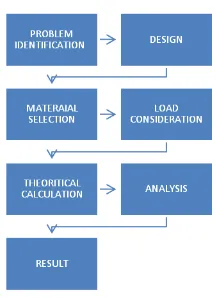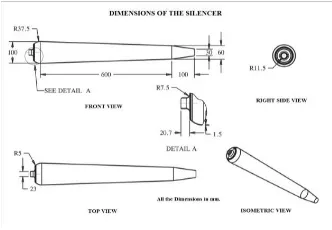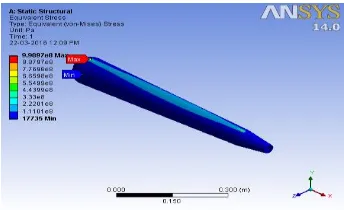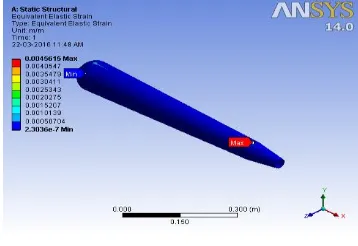© 2016, IRJET | Impact Factor value: 4.45 | ISO 9001:2008 Certified Journal
| Page 92
Design and Analysis of Automotive Silencer for Effective Corrosion
Control
Kannan P
1, Jayaseelan V
2, Gopalakrishnan D
3,
Ashok M
41
Assistant Professor, Department of Mechanical Engineering, Jayam college of Engineering and Technology,
Dharmapuri, Tamilnadu,
2,3,4
Final Year Student, Department of Mechanical Engineering, Jayam college of Engineering and Technology,
Dharmapuri, Tamilnadu
,1
kannanmec87@gmail.com ,
2jayasmech23272@gmail.com,
3
gksvips2817@gmail.com ,
4ashokshok1996@gmail.com
---***---Abstract -
Automobile silencers have the problem ofcorrosion since its existence. So new corrosion resistant materials are emerging day by day. Here, we use different corrosion resistant materials (Composites) for silencers and then they are analyzed and compared for different stresses and strains produced in the silencer both pressure and thermal loads. Then the materials are rated for their best usage. The existing material is Mild steel which is compared with our selected materials which are as follows Stainless steel, Carbon fiber and Glass fiber. We have selected these materials because of their high strength and their high resistant to corrosion. These materials are analyzed in Ansys where there Stress, Strain and Deformation were analyzed and the best material is selected accordingly and rated for their best usage.
Key Words: Corrosion resistant material, fiber, Ansys
1. INTRODUCTION
Silencer is a device which is used to carry the exhaust gases from the combustion chamber to the atmosphere. Since it carries the exhaust gases it should be resistant to heat and should withstand pressure and resist corrosion. Mostly, Silencer failure happens due to the effect of corrosion. It is due to the atmospheric conditions of our world and the acidic condensate deposit on silencer. These condensates erode the silencer material and causes
corrosion. So, corrosion resistant material should be used to avoid such circumstances. For that we’re selecting the best corrosive materials like Carbon fiber, glass fiber, stainless steel and the presently used material Mild steel and compare them with thermal and pressure load conditions and select best material which resists corrosion.
[image:1.595.379.487.451.600.2]2. METHADOLOGY
Fig 1 Flow diagram representing Methodology
2.1 .PROBLEM IDENTIFICATION
© 2016, IRJET | Impact Factor value: 4.45 | ISO 9001:2008 Certified Journal
| Page 93
Fig 2.1 Corroded silencer2.2 .DESIGN
[image:2.595.77.243.384.499.2]We have designed the silencer in Creo Parametric 2.0 and have Analysed in Ansys software. We took the dimens1ions of Splender Pro bike silencer since it is mostly used one. The cross sectional and modelled views of the silencer are shown below.
Fig 2.2 Layout of silencer
The 3d Modelled and cross sectional views are as follows,
Fig 2.4 3D Modelled view of silencer
2.3. MATERIAL SELECTION
The present material used in automobile silencer is Mild steel in which we’re going to analyze the load and thermal stresses.The materials that we’re going to analyze and compare with mild steel are Carbonfiber,Glass fiber, Stainless steel.We have selected carbon fiber because it have high corrosion resistance and it is 70% lighter than steel and it has low mass. We have selected glass fiber because it is resistant to corrosion and have high strength. We have selected stainless steel because it is the material which shows high resistant to corrosion.
2.4. LOAD CONSIDERATION
In silencer we have considered the fixed load on the top side of the silencer. This is because in Splender pro vehicle a clamp fixes the top side of the silencer as fixed to make the position of the silencer. so, Fixed load is considered here on the top side of the silencer.
2.5. THEORITICAL CALCULATION
For the Splendor pro engine specifications, The theoretically Calculated temperature, Pressure and mass flow rate are as follows
Inlet Temperature of silencer,
T1=803.90k
Inlet pressure of silencer,
P1 =2.687 bar
Mass flow Rate,
Mi= 0.036 kg/s
Inlet Velocity of Silencer,
© 2016, IRJET | Impact Factor value: 4.45 | ISO 9001:2008 Certified Journal
| Page 94
3. ANALYSIS
We have analysed the materials that we have selected for manufacturing Silencer in Ansys Software and we have found the Various Stresses and Strains Acting on them and the deformation occurring on them.
[image:3.595.54.531.41.760.2]MILD STEEL
Fig 3.1 Stress in Mild steel
[image:3.595.75.247.235.340.2]Fig 3.2 Strain in Mild steel
Fig 3.3 Deformation in Mild Steel
CARBON FIBER
[image:3.595.74.248.383.490.2]Fig 3.4 Stress in carbon fiber
[image:3.595.345.523.432.548.2]Fig 3.5 Strain in Carbon fiber
Fig 3.6 Deformation in Carbon fiber
STAINLESS STEEL
[image:3.595.68.254.558.670.2] [image:3.595.347.520.618.724.2]© 2016, IRJET | Impact Factor value: 4.45 | ISO 9001:2008 Certified Journal
| Page 95
Fig 3.8 Strain in Stainless steelFig 3.9 Deformation of stainless steel
GLASS FIBER
Fig 3.10 Stress in Glass fiber
[image:4.595.344.520.355.456.2]Fig 3.11: Strain in Glass fiber
Fig 3.12 Deformation in Glass fiber
4. RESULTS
From the Analysed figures the Stress Strain and Deformation value for those materials are as follows,
TABLE-1
STAINLESS STEEL VALUES FROM ANSYS [image:4.595.70.255.431.566.2] [image:4.595.346.519.501.590.2] [image:4.595.71.250.608.731.2]© 2016, IRJET | Impact Factor value: 4.45 | ISO 9001:2008 Certified Journal
| Page 96
TABLE- 3 GLASS FIBER VALUES FROM ANSYSTABLE- 4 CARBON FIBER VALUES FROM ANSYS
5.CONCLUSION
Analysis results from testing the silencer under static load containing the stresses and deflection are listed in the Table. The materials we have analyze are mild steel, stainless steel, glass fiber E-grade and carbon fiber.
In the analysis of silencer we have found that the carbon fiber silencer have a good strength and it have a less stress under the fixed support and force, than the other three material which are used for silencer. So the existing mild steel material can be replaced with optimized carbon fiber material because of its low deformation and elastic strain values. Compared to other optimized materials like glass fiber E-grade and stainless steel the carbon fiber has low stress value. So the suitable material for silencer is carbon fiber.
Even though Carbon fiber is costlier it should be used in manufacturing silencer since it shows the resistant to corrosion among the given materials.
6. REFERENCES
[1] Davies, P.O.A.L., “The Design of Silencers for Internal Combustion Engine” Journal of sound and Vibration, Vol.1, No.2, pp. 185- 201.1964.
[2] Hoffmann C, et al, “ Pitting corrosion in the wet section of the automotive exhaust system”, JAMME, Vol 34, 2009.
[3] Na, W., Efraimsson, G., Boij, S., “Simulations of the scattering of sound waves at a sudden area expansionin a 3D duct”, 21st International Congress on Sound and Vibration (ICSV21), Beijing, China, 13-17 July2014. [4] Patekar, V. P., Patil, R. B., “Vibrational Analysis of
Automotive Exhaust Silencer Based on FEM,andFFT Analyzer”, International Journal on Emerging Technologies 3(2), 2012, 1-3.
[5] Rajadurai S, et al. “ Materials for automotive exhaust system”, IJRDET, Vol 2,2014.
[6] Vinay Gupta, Dhananjay Singh, Dhirendra Singh & Madan Mohan Mishra , “Vibrational analysis of exhaust muffler”, IJSER,2013.
© 2016, IRJET | Impact Factor value: 4.45 | ISO 9001:2008 Certified Journal
| Page 97
BIOGRAPHIES
KANNAN P
1Assistant Professor,
Department of
Mechanical Engineering,
Jayam college of
Engineering and
Technology, Dharmapuri,
Tamilnadu,



